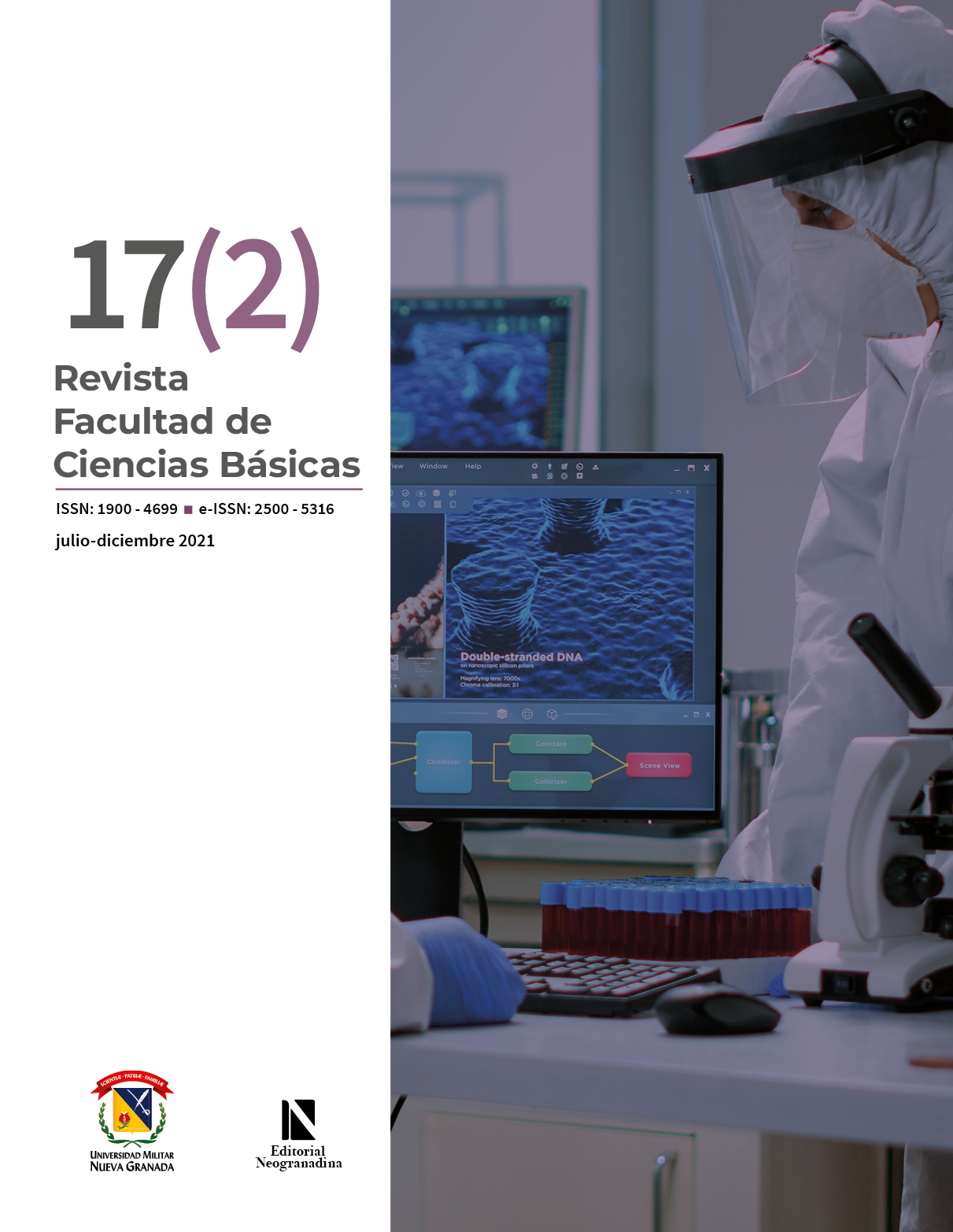Potential Antimicrobial Activity of the Peptide btm-P1 in Foods
Abstract
One of the challenges of the food industry is preserving food, for which techniques have been developed to prolong the integrity of their nutrients and sensory properties for as long as possible. One of the main problems is bacterial contamination, which has been treated with synthetic
antibiotics but may leave toxic residues for human consumption. Additionally, there is concern about
diseases caused by bacteria that develop microbial resistance from prolonged use of antibiotics.
Therefore, natural alternatives such as nisin have been used successfully for several decades, despite some limitations that could be overcome by researching and testing new antimicrobial peptides. The btm-P1 peptide is a polycationic molecule derived from the natural protoxin Cry11Bb1 of Bacillus thuringiensis subspecies Medellin, which has shown the ability to destroy bacteria, making
it a potential food preservative. The purpose of this study was to evaluate the antimicrobial activity of the btm-P1 peptide with typical food bacteria, such as Escherichia coli, Salmonella sp., and Listeria monocytogenes. This activity was studied with cultures under different physicochemical conditions to emulate different peptide environments in foods. It was shown that Listeria monocytogenes was
the bacteria with the best recovery after incubation with the peptide at different temperatures, and pre-storage of btm-P1 in acidic environments increased its antimicrobial activity against Escherichia coli. It is concluded that the btm-P1 peptide maintains its antimicrobial activity in incubation media with pH ranging from 3 to 7 and temperatures ranging from 4 to 37 °C.
Downloads
References
M.M. Aung y Y.S. Chang, “Traceability in a food supply chain: Safety and quality perspectives”, Food Control, vol. 39, pp. 172-184, 2014, doi: 10.1016/j.foodcont. 2013.11.007.
G. El-Saber Batiha, D.E Hussein, A.M. Algammal, T.T. George, P. Jeandet, A.E. Al-Snafi, A. Tiwari, J.P. Pagnossa, C.M. Lima, N.D. Thorat, M. Zahoor, M. El-Esawi, A. Dey, S. Alghamdi, H.F. Hetta y N.Cruz-Martins, “Application of natural antimicrobials in food preservation: recent views”, Food Control, vol. 126, pp. 1080-66, 2021, doi: 10.1016/j.foodcont.2021.108066.
D.G. Newell, M. Koopmans, L. Verhoef, E. Duizer, A. Aidara-Kane, H. Sprong, M. Opsteegh, M. Langelaar, J. Threfall, F. Scheutz, J. van der Giessen y H. Kruse, “Food-borne diseases - the challenges of 20 years ago still persist while new ones continue to emerge”, Int. J. Food. Microbiol., vol. 139, pp. S3-S15, 2010, doi: 10.1016/j.ijfoodmicro.2010.01.021.
I.A. Rather, W.Y. Koh, W.K. Paek y J. Lim, “The sources of chemical contaminants in food and their health implications”, Front. harmacol., vol. 8, pp. 830, 2017, doi: 10.3389/fphar.2017.00830.
D.M. Tack, L. Ray, P.M. Griffin, P.R. Cieslak, J. Dunn, T. Rissman, R. Jervis, S. Lathrop, A. Muse, M. Duwell, K. Smith, M. Tobin-D’Angelo, D.J. Vugia, J. Zablotsky, B.J. Wolpert, R. Tauxe y D.C. Payne, “Preliminary incidence and trends of infections with pathogens transmitted commonly through food - foodborne diseases active surveillance network, 10 U.S. Sites, 2016-2019”, mmwr Morb. Mortal. Wkly. Rep., vol. 69, no. 17, pp. 509-514, 2020, doi: 10.15585/mmwr.mm6917a1.
D.C. Love, E.M. Nussbaumer, J. Harding, J.A. Gephart, J.L. Anderson, F. Asche, J.S. Stoll, A.L.Thorne-Lyman y M.W. Bloem, “Risks shift along seafood supply chains” Glob. Food Sec., vol. 28, pp. 1004-76, 2021, doi: 10.1016/j.gfs.2020.100476.
A. J. St. Angelo J. Vercellotti, T. Jacks y M. Legendre, “Lipid oxidation in foods”, Crit. Rev. Food Sci. Nutr., vol. 36, no. 3, pp. 175-224, 1996, doi: 10.1080/10408399609527723.
R. Franco, G. Navarro y E. Martínez-Pinilla, “Antioxidants versus food antioxidant additives and food preservatives”, Antioxidants (Basel), vol. 8, no. 11, pp. 542, 2019, doi: 10.3390/antiox8110542.
C.N. Cutter, “Microbial control by packaging: a review”, Crit. Rev. Food Sci. Nutr., vol. 42, no. 2, pp. 151-161, 2002, doi:10.1080/10408690290825493.
L. Gram, L. Ravn, M. Rasch, J.B. Bruhn, A.B. Christensen y M. Givskov, “Food spoilage--interactions between food spoilage bacteria”. Int. J. Food. Microbiol.,vol. 78, no. 1-2, pp. 79-97, 2002, doi: 10.1016/s0168-1605(02)00233-7.
D. Dave y A.E. Ghaly, “Meat spoilage mechanisms and preservation techniques: a critical review”, Am. J. Agric. Biol. Sci., vol. 6, no. 4, pp. 486-510, 2011, doi:10.3844/ajabssp.2011.486.510.
B. Ramos, F.A. Miller, T.R.S. Brandão, P. Teixeira y C.L.M. Silva, “Fresh fruits and vegetables - an overview on applied methodologies to improve its quality and safety”, Innov. Food. Sci. Emerg. Technol., vol. 20, pp. 1-15, 2013, doi: 10.1016/j.ifset.2013.07.002.
N. Upadhyay, A. Goyal, A. Kumar, D. Lal Ghai y R. Singh, “Preservation of milk and milk products for analytical purposes”, Food Rev. Int., vol. 30, no. 3, pp. 203-224, 2014, doi: 10.1080/87559129.2014.913292.
M. Zarei, N. Basiri, A. Jamnejad y M.H. Eskandari, “Prevalence of Escherichia coli O157:H7, Listeria monocytogenes and Salmonella spp. in beef, buffalo and lamb using multiplex pcr”, Jundishapur J. Microbiol., vol. 6, no. 8, pp. e7244, 2013, doi: 10.5812/jjm.7244
R.E. Patiño-Burbano, A.K. Carrascal, J. L. Parra-Arango, J. L. Rodríguez-Bautista y J. C. Salcedo-Reyes, “Assessment of a multiplex detection method for Salmonella enterica, Escherichia coli O157:H7, and Listeria monocytogenes in cow milk”, Univ. Sci., vol. 24, no. 1, pp. 200-217, 2019, doi:10.11144/javeriana.sc24-1.aoam.
E. Abebe, G. Gugsa y M. Ahmed, “Review on major food-borne zoonotic bacterial pathogens”, J. Trop. Med., vol. 2020, ID. 4674235, 2020, doi:10.1155/2020/4674235.
C. Kirchhelle, “Pharming animals: a global history of antibiotics in food production (1935–2017)”, Palgrave Commun., vol. 4, no. 96, 2018, doi: 10.1057/s41599-018-0152-2.
Chen, G.G. Ying y W.J. Deng, “Antibiotic residues: extraction, analysis, and human health concerns”,J. Agric. Food. Chem., vol. 67, no. 27, pp. 7569-7586, 2019, doi: 10.1021/acs.jafc.9b01334.
Vaishali, P. Jhandai, V.J. Jadhav y R. Gupta, “Bio-preservation of foods: a review”, Eur. J. Nutr. Food. Saf., vol. 11, no. 4, pp. 164-174, 2019, doi: 10.9734/ejnfs/2019/v11i430159.
M. Rai, R. Pandit, S. Gaikwad y G. Kövics, “Antimicrobial peptides as natural bio-preservative to enhance the shelf-life of food”, J. Food Sci. Technol., vol. 53, no. 9, pp. 3381-3394, 2016, doi: 10.1007/s13197-016-2318-5.
E. Dell’Olmo, R. Gaglione, M. Sabbah, M. Schibeci, A. Cesaro, R. Di Girolamo, R. Porta y A. Arciello, “Host defense peptides identified in human apolipoprotein B as novel food biopreservatives and active coating components”, Food Microbiol., vol. 99, pp:103-804, 2021, doi.org/10.1016/j.fm.2021.103804.
M.L. Heymich, S. Srirangan y M. Pischetsrieder, “Stability and activity of the antimicrobial peptide Leg1 in solution and on meat and its optimized generation from chickpea storage protein”, Foods, vol. 10, no. 6, pp: 1192, 2021, doi: 10.3390/foods10061192
Y.L. Vishweshwaraiah, A. Acharya, V. Hegde y B. Prakash, “Rational design of hyperstable antibacterial peptides for food preservation”, npj Sci. Food, vol. 5, no. 1, pp. 26, 2021, doi:10.1038/s41538-021-00109-z.
A. Gharsallaoui, N. Oulahal, C. Joly y P. Degraeve, “Nisin as a food preservative: part 1: physicochemical properties, antimicrobial activity, and main uses”, Crit. Rev. Food Sci. Nutr., vol. 56, no. 8, pp. 1262-1274, 2016, doi: 10.1080/10408398.2013.763765.
K. Rayman, N. Malik y A. Hurst, “Failure of nisin to inhibit outgrowth of Clostridium botulinum in a model cured meat system”, Appl. Environ. Microbiol., vol. 46, no. 6, pp. 1450-1452, 1983, doi: 10.1128/ AEM.46.6.1450-1452.1983.
A. Sobrino-López y O. Martín-Belloso, “Use of nisin and other bacteriocins for preservation of dairy products”, Int. Dairy J., vol. 18, pp. 329-343, 2008, doi: 10.1016/j.idairyj.2007.11.009.
M.L. Van Tassell, L.A. Ibarra-Sánchez, S.R. Takhar, S.L Amaya-Llano y M.J. Miller, “Use of a miniature laboratory fresh cheese model for investigating antimicrobial activities” J. Dairy Sci., vol. 98 (26454301), pp. 8515-8524, 2015, doi: 10.3168/jds.2015-9967.
C.N. Cutter y G.R. Siragusa, “Population reductions of gram-negative pathogens following treatments with nisin and chelators under various conditions”, J. Food. Prot., vol. 58, no. 9, pp. 977-983, 1995, doi: 10.4315/0362-028X-58.9.977
J.K. Branen y P.M. Davidson, “Enhancement of nisin, lysozyme, and monolaurin antimicrobial activities by ethylenediaminetetraacetic acid and lactoferrin”, Int. J. Food Microbiol., vol. 90, no. 1, pp. 63-74, 2004, doi: 10.1016/s0168-1605(03)00172-7.
I.S. Boziaris, L. Humpheson y M.R. Adams, “Effect of nisin on heat injury and inactivation of Salmonella enteritidis pt4”, Int. J. Food Microbiol., vol. 43, no. 1-2, pp. 7-13, 1998, doi: 10.1016/s0168-1605(98)00083-x
W. Liu y J.N. Hansen, “Some chemical and physical properties of nisin, a small-protein antibiotic produced by Lactococcus lactis”, Appl. Environ. Microbiol., vol. 56 (2119570), pp. 2551-2558, 1990.
E.A. Davies, H.E. Bevis, R. Potter, J. Harris, G.C. Williams y J. Delves-Broughton, “Research note: The effect of pH on the stability of nisin solution during autoclaving”, Lett. Appl. Microbiol., vol. 27, pp. 186-187, 1998, doi: 10.1046/j.1472-765X.1998.t01-1-00401.x
V.V. Lemeshko, M. Arias y S. Orduz, “Mitochondria permeabilization by a novel polycation peptide btm-P1”, J. Biol. Chem., vol. 280, no. 16, pp. 15579-15586, 2005, doi: 10.1074/jbc.M414064200
C. Segura, F. Guzmán, L.M. Salazar, M.E. Patarroyo, S. Orduz y V. Lemeshko, “BTM-P1 polycationic peptide biological activity and 3D-dimensional structure”, Biochem. Biophys. Res. Commun., vol. 353, no. 4, pp. 908-914, 2007, doi: 10.1016/j.bbrc.2006.12.113.
V.V. Lemeshko, F. Guzmán, M.E. Patarroyo, C. Segura y S. Orduz, “Synthetic peptide having an ionophoric and antimicrobial activity”. U.S. Patent No. 7.041.647, 2005.
V.V. Lemeshko, “Permeabilization of mitochondria and red blood cells by polycationic peptides btm-P1 and retro-btm-P1”, Peptides, vol. 32, no. 10, pp. 2010- 2020, 2011, doi: 10.1016/j.peptides.2011.08.023.
J.M. Andrews, “Determination of minimum inhibitory concentrations”, J. Antimicrob. Chemother. vol.48, no. 1, pp. 5-16, 2001, doi:10.1093/jac/48.suppl_1.5.
Clinical and Laboratory Standard Institute (clsi), “Methods for dilution antimicrobial susceptibility tests for bacteria that grow aerobically”, approved standard-ninth edition, M07-A9, vol. 32, no. 2, pp. 18-20, 2012.
J.M. Shin, I. Ateia, J.R. Paulus, H. Liu, J.C. Fenno, A.H. Rickard y Y.L. Kapila, “Antimicrobial nisin acts against saliva derived multi-species biofilms without cytotoxicity to human oral cells”, Front. Microbiol., vol. 6, pp. 617, 2015, doi: 10.3389/fmicb.2015.00617
A.P. Schellinger y P.W. Carr, “Solubility of Buffers in Aqueous-Organic Eluents for Reversed-Phase Liquid Chromatography”, lcgc North America, vol. 22, no. 6, pp. 544-548, 2004.
N. Malanovic y K. Lohner, “Gram-positive bacterial cell envelopes: the impact on the activity of antimicrobial peptides”, Biochim. Biophys. Acta, vol.1858, no. 5, pp. 936-946, 2016, doi: 10.1016/j.bbamem.2015.11.004.
G. Bhardwaj, V. Khipple, C.D. Bahl, J.M. Gilmore, P.J. Harvey, O. Cheneval, G.W. Buchko, S.V.S.R.K Pulavarti, Q. Kaas, A. Eletsky, P.S. Huang, W.A. Johnsen, P.J. Greisen, G.J. Rocklin, Y. Song, T.W. Linsky, A. Watkins, S.A. Rettie, X. Xu, L.P. Carter, R. Bonneau, J.M. Olson, E. Coutsias,
C.E. Correnti, T. Szyperski, D.J. Craik y D. Baker, “Accurate de novo design of hyperstable constrained peptides”, Nature, vol. 538, pp. 329-335, 2016, doi: 10.1038/nature19791.
D. Bogahawaththaa, J. Chandrapalaab y T. Vasiljevic, “Thermal denaturation of bovine immunoglobulin G and its association with other whey proteins”. Food Hydrocoll., vol. 72, pp. 350-357, 2017, doi: 10.1016/j.foodhyd.2017.06.017.
A. Bañares-Hidalgo, J. Pérez-Gil y P. Estrada, “Acidic pH triggers conformational changes at the nh2-terminal propeptide of the precursor of pulmonary surfactant protein B to form a coiled coil structure”, Biochim. Biophys. Acta, vol. 1838, no. 7, pp. 1738-1751, 2014, doi: 10.1016/j.bbamem.2014.03.016.
V. Cabra, R. Arreguin, R. Vásquez-Duhalt y A. Farres, “Effect of temperature and pH on the secondary structure and processes of oligomerization of 19 kDa alpha-zein”, Biochim. Biophys. Acta, vol. 1764, no. 6, pp. 1110-1118, 2006, doi: 10.1016/j.bbapap.2006.04.002.
J. Membre, B. Leporq, M. Vialette, E. Mettler, L. Perrier, D. Thuault y M. Zwietering,“Temperature effect on bacterial growth rate: quantitative microbiology approach including cardinal values and variability estimates to perform growth simulations on/in food”. Int. J. Food Microbiol., vol. 100, no. 1-3, pp. 179-186, 2005, doi: https://doi.org/10.1016/j.ijfoodmicro.2004.10.015.
E. Gasteiger, C. Hoogland, A. Gattiker, S. Duvaud, M.R. Wilkins, R.D. Appel y A. Bairoch, “Protein identification and analysis tools on the ExPASy Server”, (In) John M. Walker (ed): The Proteomics Protocols Handbook, Humana Press, 2005.
V.V. Lemeshko y S. Orduz, “Electrical hypothesis of toxicity of the Cry toxins for mosquito larvae”, Biosci Rep., vol. 33, no. 1, pp. 125-136, 2013, doi: 10.1042/BSR20120101.
H.M. Werner, C.C. Cabalteja y W.S. Horne, “Peptide backbone composition and protease susceptibility: impact of modification type, position, and tandem substitution”, Chembiochem., vol. 17, no. 8, pp. 712- 718, 2016, doi: 10.1002/cbic.201500312.
R. Rink, A. Arkema-Meter, I. Baudoin, E. Post, A. Kuipers, S.A. Nelemans, M. Haas Jimoh y G.N. Moll, “To protect peptide pharmaceuticals against peptidases”, J. Pharmacol. Toxicol. Methods, vol. 61, no. 2, pp. 210-218, 2010, doi: 10.1016/j.vascn.2010.02.010.

Copyright (c) 2023 Revista Facultad de Ciencias Básicas

This work is licensed under a Creative Commons Attribution-NonCommercial-NoDerivatives 4.0 International License.











